Happy days on the Cook Islands
With friendly locals and a yesteryear vibe, the Cook Islands rate highly on ‘secret hotspot’ lists.
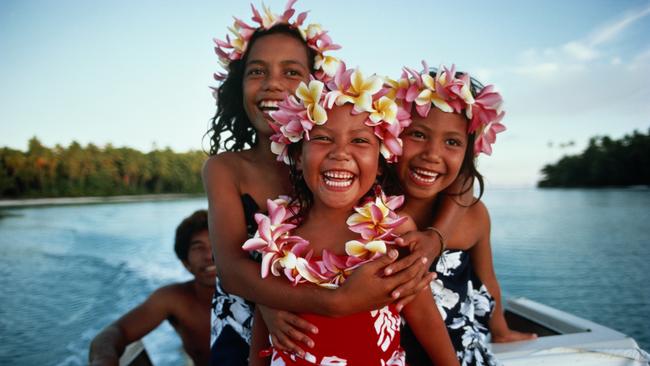
There’s an odd little thing about arrival in the Cook Islands after a six-hour flight from Sydney. The place is very much part of our South Pacific region; as a nation in “free association” with New Zealand it uses the kiwi dollar. But because it lies just the other side of the International Date Line, today becomes yesterday.
Step back into yesterday, yesteryear even. The Cook Islands have been compared to, say, Hawaii five decades ago as they rate highly on the “secret hotspot” lists. But that’s not the full story. Relax, do nothing, be a beachcomber, sure. But the locals are an enterprising lot inspired in part by their kin drawn home by the love of island life after stays in Australia and NZ. They bring fresh ideas in hospitality. Accommodation is good, there’s fine choice in dining, and services from laid-back sightseeing to adventure tourism, water sports and game fishing are easily arranged.
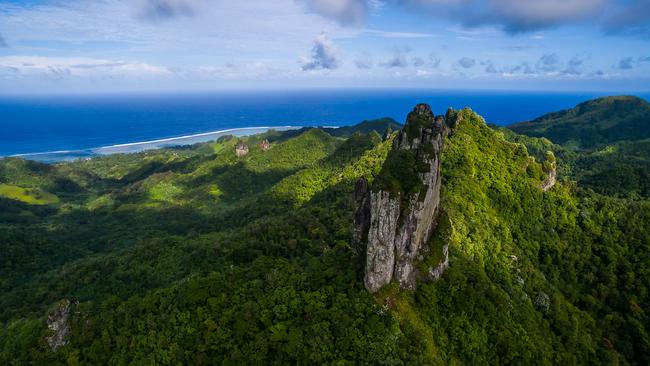
So let’s get our bearings. The Cook Islands rest on the Tropic of Capricorn (think Rockhampton) south of Hawaii. There are 15 islands in the nation, which has a footprint about a quarter the size of Australia, but with just 240sq km above water.
Marvellous Polynesian seafarers arrived in their vakas, giant double-hulled canoes, about 800AD and later set forth for New Zealand. James Cook charted a few of the islands in 1773 and 1777 but missed today’s main visitor destinations, Rarotonga and Aitutaki. He named what he saw the Hervey Islands and it was the Russians of all people who gave them the Cook moniker. William Bligh called in just days before the boys on the Bounty mutinied in 1789. But the arrival of the Reverend John Williams of the London Missionary Society in 1821 changed everything. Cannibalism, the butt of much island humour, was off the table, for example, and the Christian legacy endures strongly. Get ready for a closed-shop Sunday and saying grace before meals.
Rarotonga (or just Raro) rises heroically from the ocean, a lushly vegetated volcanic remnant of peaks and serrated ridges. It is encircled by a reef forming a lagoon that can be (let me check the colour chart) baby, sky, azure and sapphire blue — tick all, depending on the clouds and tide movements. A rhapsody in blue.
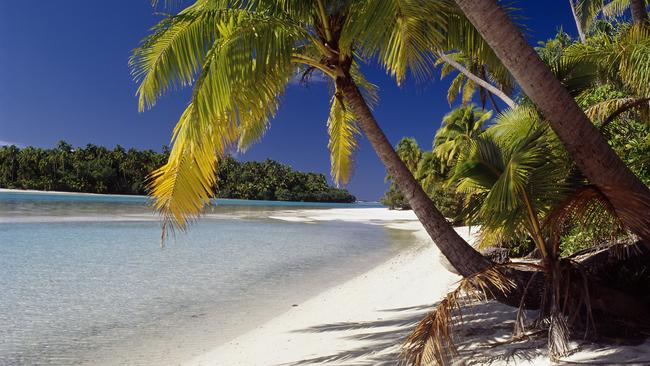
A 32km road shoulders the shoreline, with sections of an older, historic path just a little inland. A rental car is useful but there are scooters and bikes for hire and two bus routes, clockwise and anticlockwise.
What gives the place a yesteryear feel? It’s the informality for a start, like the friendly dogs that meander along with walkers, yielding to a mate to take over along the path. There was a historic Polynesian breed, but today’s canines have definite European links, including some with corgi blood. Folklore has it that one of the Queen’s corgis escaped on a visit, but that sounds like a shaggy dog story.
Then there are the hundreds of free-range fowls that scrabble around, often with chicks; the cock’s crow is a keen competitor with the crashing of waves on the reef as a wake-up call. Maybe this is the Chook Islands. But my fondest memory is of the love of music and song. I’ve been told a Sunday church service is a must, but am hesitant. I respect other people’s beliefs but am not big on damnation. There is none of it at Titikaveka Cook Islands Christian Church, just glorious voices expressing praise, gratitude and joy. It’s the first Sunday of the month, which means Communion, and Father’s Day, so the parishioners, who welcome visitors, are dressed in pearly white, the women choristers in woven palm-leaf roti hats and mumus. The church, dating from 1835, is light and bright with heavenly blue and earth-brown pillars; the beautiful voices, blending hymns with traditional song, raise the rafters. During a poem for fathers, I think of my own (who died almost 12 years to the day) and my eyes well up.
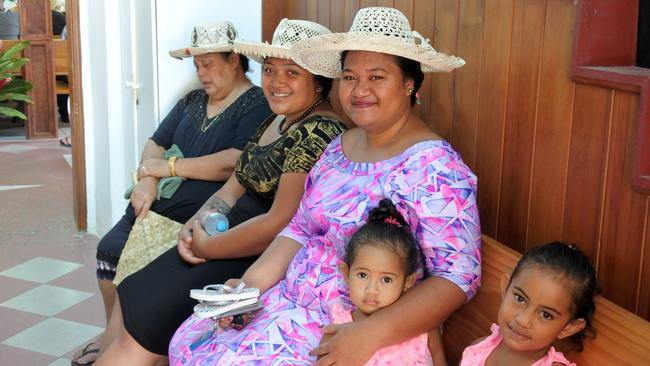
A Raro Mountain Safari provides an entertaining introduction to Cook Islands history and traditions, well worth taking early in a stay. Guests (Australians, New Zealanders and North Americans) pile into a convoy of open-sided Jeeps and we’re away through cultivated land in the foothills learning about the crops — coconut palms, known as the tree of life because of their all-round usefulness, bananas, mangoes, pineapples, avocados, basil plants the height of a tree, and staples of taro, breadfruit and arrowroot. And right up there, pawpaws, which are the taste sensation of the trip.
We learn that land ownership is in the hands of island clans (leases are available, but a visitor will never be able to possess a piece of paradise) and that, essentially, the embrace of family is everything. That explains why many houses have well-tended graves and stone memorials in their front and backyards. Some visitors find this challenging, but I like the sense of togetherness in life and death.
Our vehicles charge up a gravel road to a clearing in the densely forested highlands where there is a stunning view of The Needle rocky outcrop in one direction and the Pacific in the other. We have a lesson in cracking a coconut in a more strategic way than brute force with furrowed brow and bruised fingers.
There’s more to learn about Raro life on a Te Vara Nui island night, which combines a cultural village tour with buffet dinner and show on an overwater stage. The dancers are mesmerising, so too the drummers. You get the feeling the missionaries never quite stamped out all of this hedonism. The venue is the vision of matriarch Vara Hunter, entertainer, lifelong promoter of island culture and one-time friend of Marlon Brando. She stops by some evenings to keep an eye on proceedings, which are hosted by Ruth Anna Tangiiau Mave, a smart Cookie with a dry wit.
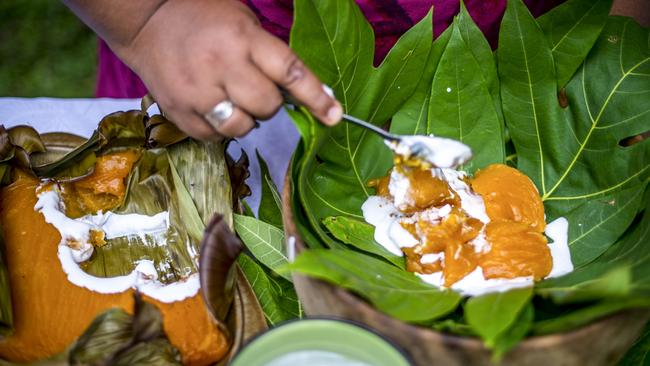
On a Progressive Dinner Tour, conducted by Cook Island Tours, visitors are invited into three homes, for entrees, mains and dessert. Our hosts are warm and humorous and, as we sit on their deep verandas sampling the dishes, they join tour boss Temu Okotai in serenades with ukuleles and guitars.
Expect traditional dishes such as ika mata (fresh raw fish in coconut cream), rukau (taro leaves), paw paw salad and poke (a cooked pudding, with banana, paw paw and coconut milk). Meats may be cooked umu style, in a traditional earth oven. Temu rounds out the night with the lyrical national anthem. “You’re unlikely to hear it at the Olympic Games,” he notes.
For contemporary dining, ask the locals; the names that keep cropping up are Beluga, in Arorangi district, for breakfast and lunch, and The Lazy Trout in the main town of Avarua, but the choice in cuisine styles is diverse. The cafe in a converted container at Ariki Adventures serves excellent coffee.
We have been staying at Sea Change Villas; our bungalow, with a cathedral ceiling under an ornamental thatched roof, is brand new and absolute beachfront. A spacious living and dining area, with fully equipped kitchen, opens to a veranda overlooking the lagoon, reef and, 100m away, the ocean. The interior is all white and green, with splashes of floral designs and island art and carvings.
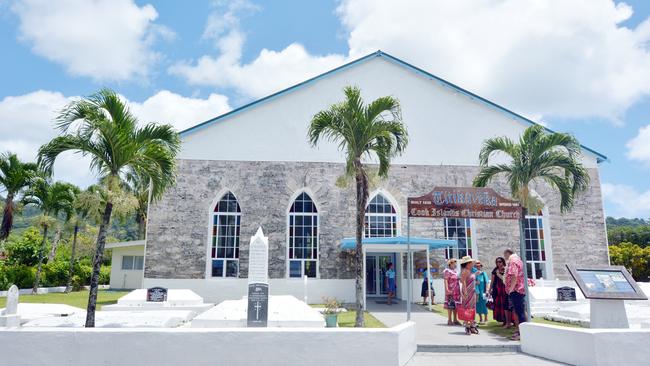
The main bedroom has a comfy four-poster bed, with dressing area and ensuite. A separate bedroom opens on to a deck courtyard with private pool.
Complimentary snorkelling gear, paddleboards and canoes are available when it’s time to walk off the veranda and cross the white sand to the lagoon’s inviting water, alive with tropical fish.
In the days to come, we’ll take the short flight to Aitutaki, where the pace goes down a notch, if that’s possible. Staying in the five-star Pacific Resort in a bungalow I want to claim as home, we spend a day on a Vaka Cruise, weaving around dream atolls, swimming with turtles and giant trevally and being entertained by crew who pick up ukuleles and sing between maritime chores. The captain steers and plays drum. I’ve been holding off using the word idyllic, but it’s time.
Back home, I have my own small wooden drum, with stick, bought at Raro’s Punanga Nui Markets, which is the place to go on a Saturday morning for arts, crafts, produce, food and entertainment. I manage a paltry sound tapping it, nothing like the rhythmic magic of island drummers. But it has carved on it the words Kia Orana, the traditional greeting I’ve encountered throughout the stay. It means “may you live long”. I like the sound of that.
Graham Erbacher was a guest of Cook Islands Tourism.
-
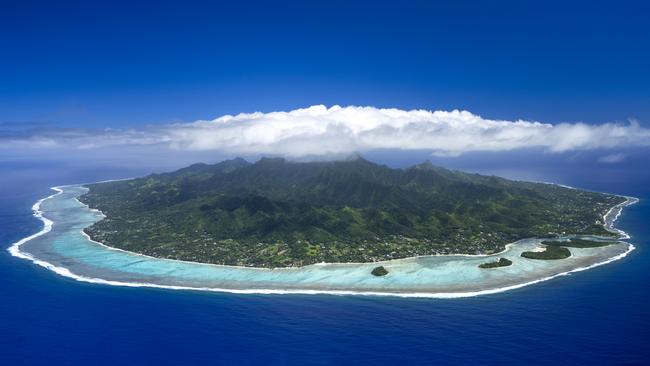
IN THE KNOW
Cook Islands Escapes has packages to the Cook Islands combining Rarotonga and Aitutaki from $2760 a person, including three nights at Sea Change Villas, Rarotonga, and three nights at Pacific Resort Aitutaki; airport transfers included; 1800 622 523.
Air Rarotonga flies between Rarotonga and Aitutaki.
Air New Zealand offers a weekly direct service from Sydney to Rarotonga, departing and returning on Fridays. It also flies to Rarotonga via Auckland from Australian capital cities.
-
MORE TO THE STORY
Board the pick-up bus at 10am for the popular Cross Island Walk. Our guide is Bruce Goldsworthy, nephew of Pa Teuruaa, a local legend who retired earlier this year after conducting 5000 walks over a period of 33 years. Pa pops in at the start of our hike for a quick flesh-press, but reserves his energies these days for his famous medicinal walks.
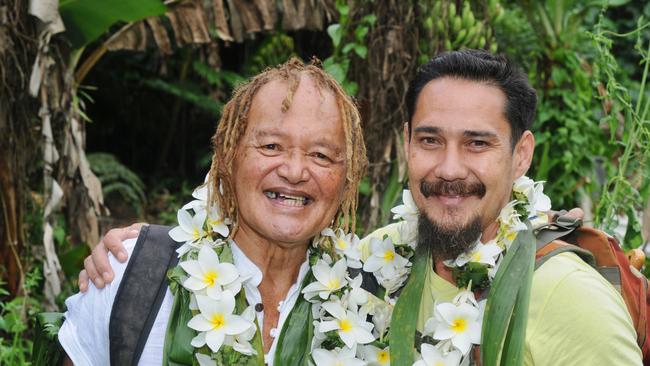
The 400m ascent is steep, a bit muddy and the air thins; however, ladder-like, tree roots unfailingly furnish a hiker’s three points of contact. Our party is a delight: 20s to 70s in age, mainly Californians and Kiwis. Bruce is a considerate guide, passionate about his land and its natural and social history.
At the base of The Needle, we get the full Jurassic Park vista — sweeping curtains of green draped over bones of giants. Everything is giant here, including ferns, hibiscus and taro (elephant’s ears).
You can climb a bit higher using embedded chains and ropes for a token photo, but it’s your call. The descent to the other side of the island is slippery and muddy, but there are always ropes and chains to grasp.
Back on the flat, there’s time for a thrilling dip at Wigmore’s Waterfall (beneath an unfortunate PVC pipe). A short traipse further and we meet our minibus, where lunch is ready and Pa reappears for a friendly goodbye. A reasonable level of fitness is recommended, but don’t feel too intimidated. Wear shoes with tread and take something warm (the summit is cool in September). Pack swimwear, a towel and mozzie repellent. Home by 3.
ALAN FRENCH

To join the conversation, please log in. Don't have an account? Register
Join the conversation, you are commenting as Logout